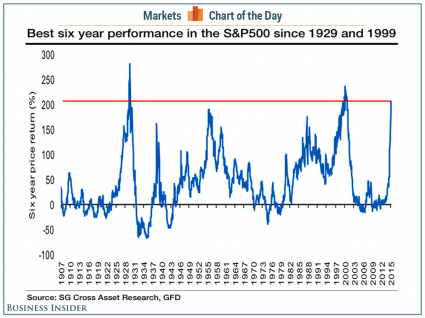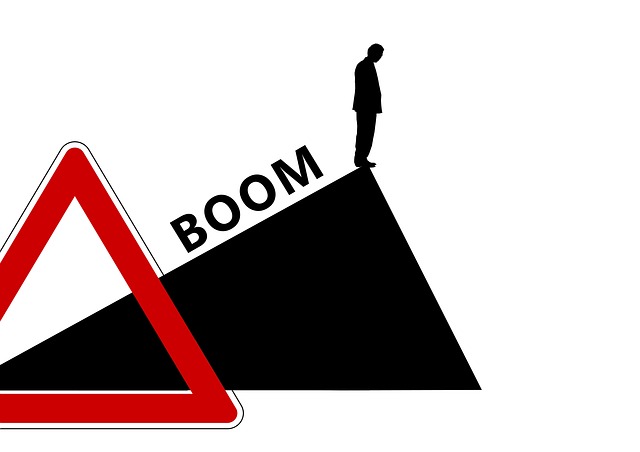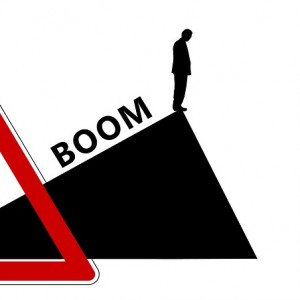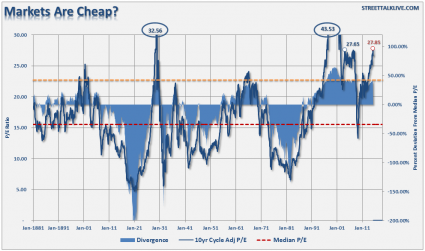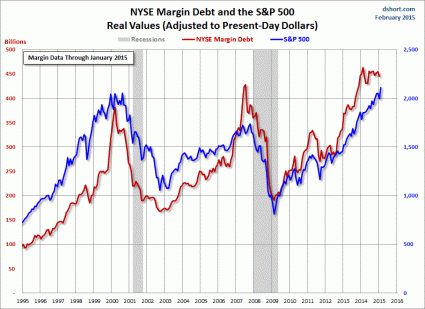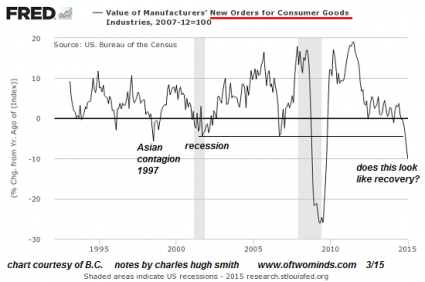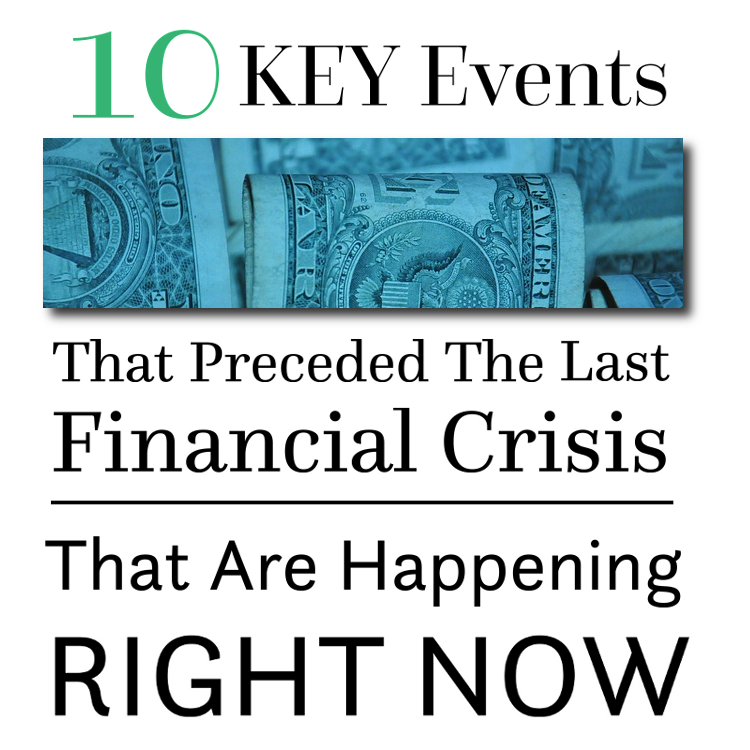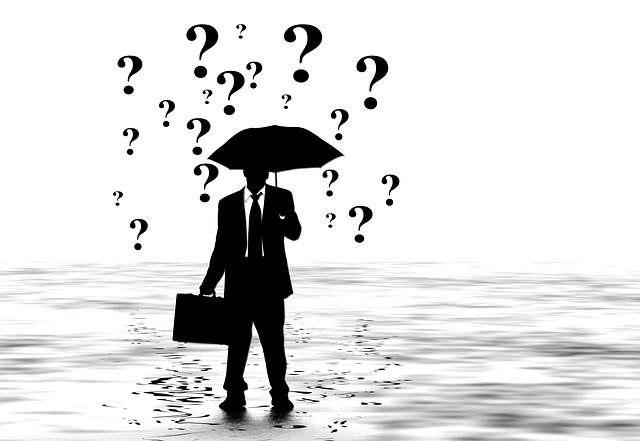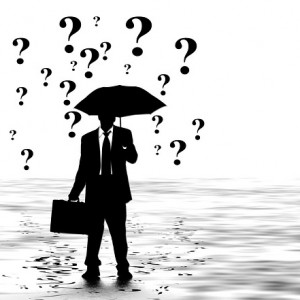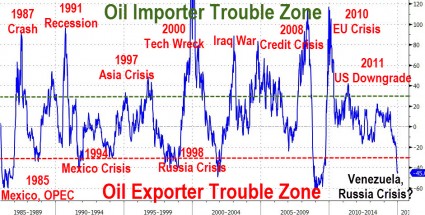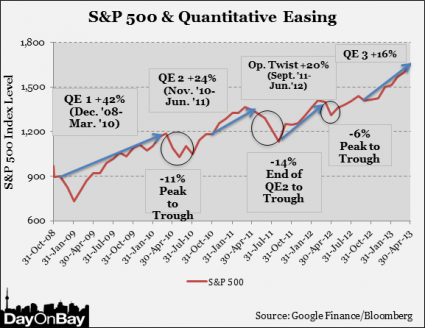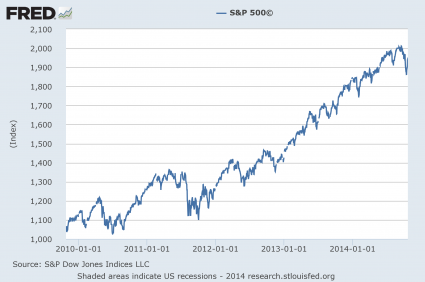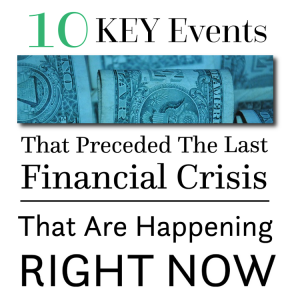 If you do not believe that we are heading directly toward another major financial crisis, you need to read this article. So many of the exact same patterns that preceded the great financial collapse of 2008 are happening again right before our very eyes. History literally appears to be repeating, but most Americans seem absolutely oblivious to what is going on. The mainstream media and our politicians are promising them that everything is going to be okay somehow, and that seems to be good enough for most people. But the signs that another massive financial crisis is on the horizon are everywhere. All you have to do is open up your eyes and look at them.
If you do not believe that we are heading directly toward another major financial crisis, you need to read this article. So many of the exact same patterns that preceded the great financial collapse of 2008 are happening again right before our very eyes. History literally appears to be repeating, but most Americans seem absolutely oblivious to what is going on. The mainstream media and our politicians are promising them that everything is going to be okay somehow, and that seems to be good enough for most people. But the signs that another massive financial crisis is on the horizon are everywhere. All you have to do is open up your eyes and look at them.
Bill Gross, considered by many to be the number one authority on government bonds on the entire planet, made headlines all over the world on Tuesday when he released his January Investment Outlook. I don’t know if we have ever seen Gross be more negative about a new year than he is about 2015. For example, just consider this statement…
“When the year is done, there will be minus signs in front of returns for many asset classes. The good times are over.”
And this is how he ended the letter…
And so that is why – at some future date – at some future Ides of March or May or November 2015, asset returns in many categories may turn negative. What to consider in such a strange new world? High-quality assets with stable cash flows. Those would include Treasury and high-quality corporate bonds, as well as equities of lightly levered corporations with attractive dividends and diversified revenues both operationally and geographically. With moments of liquidity having already been experienced in recent months, 2015 may see a continuing round of musical chairs as riskier asset categories become less and less desirable.
Debt supercycles in the process of reversal are not favorable events for future investment returns. Father Time in 2015 is not the babe with a top hat in our opening cartoon. He is the grumpy old codger looking forward to his almost inevitable “Ides” sometime during the next 12 months. Be cautious and content with low positive returns in 2015. The time for risk taking has passed.
So why are Gross and so many other financial experts being so “negative” right now?
It is because they can see what is happening.
They can see the same patterns that we saw in early 2008 unfolding again right in front of us. I wanted to put these patterns in a single article so that they will be easy to share with people. The following are 10 key events that preceded the last financial crisis that are happening again right now…
#1 A really bad start to the year for the stock market. During the first three trading days of 2015, the S&P 500 was down a total of 2.73 percent. There are only two times in history when it has declined by more than three percent during the first three trading days of a year. Those years were 2000 and 2008, and in both years we witnessed enormous stock market declines.
#2 Very choppy financial market behavior. This is something that I discussed yesterday. In general, calm markets tend to go up. When markets get choppy, they tend to go down. For example, the chart that I have posted below shows how the Dow Jones Industrial Average behaved from the beginning of 2006 to the end of 2008. As you can see, the Dow was very calm as it rose throughout 2006 and most of 2007, but it got very choppy as 2008 played out…
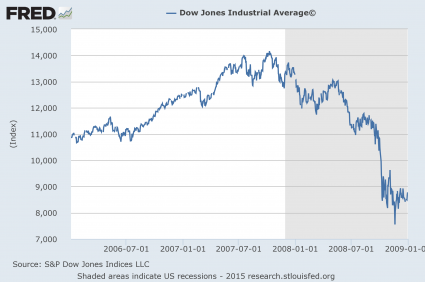
As I also mentioned yesterday, it is important not to get fooled if stocks soar on a particular day. The three largest single day stock market gains in history were right in the middle of the financial crisis of 2008. When you start to see big ups and big downs in the market, that is a sign of big trouble ahead. That is why it is so alarming that global financial markets have begun to become quite choppy in recent weeks.
#3 A substantial decline for 10 year bond yields. When investors get scared, there tends to be a “flight to safety” as investors move their money to safer investments. We saw this happen in 2008, and that is happening again right now.
In fact, according to Bloomberg, global 10 year bond yields have already dropped to low levels that are absolutely unprecedented…
Taken together, the average 10-year bond yield of the U.S., Japan and Germany has dropped below 1 percent for the first time ever, according to Steven Englander, global head of G-10 foreign-exchange strategy at Citigroup Inc.
That’s not good news. The rock-bottom rates, which fall below zero when inflation is taken into account, show “that investors think we are going nowhere for a long time,” Englander wrote in a report yesterday.
#4 The price of oil crashes. As I write this, the price of U.S. oil has dipped below $48 a barrel. But back in June, it was sitting at $106 at one point. As the chart below demonstrates, there is only one other time in history when the price of oil has declined by more than $50 in less than a year…
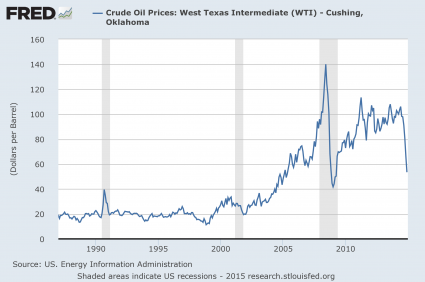
The only other time there has been an oil price collapse of this magnitude we experienced the greatest financial crisis since the Great Depression shortly thereafter. Are we about to see history repeat? For much more on this, please see my previous article entitled “Guess What Happened The Last Time The Price Of Oil Crashed Like This?”
#5 A dramatic drop in the number of oil and gas rigs in operation. Right now, oil and gas rigs are going out of operation at a frightening pace. During the fourth quarter of 2014, 93 oil and gas rigs were idled, and it is being projected that another 200 will shut down this quarter. As this Business Insider article demonstrates, this is also something that happened during the financial crisis of 2008 and it continued well into 2009.
#6 The price of gasoline takes a huge tumble. Millions of Americans are celebrating that the price of gasoline has plummeted in recent weeks. But they were also celebrating when it happened back in 2008 as well. But of course it turned out that there was really nothing to celebrate in 2008. In short order, millions of Americans lost their jobs and their homes. So the chart that I have posted below is definitely not “good news”…
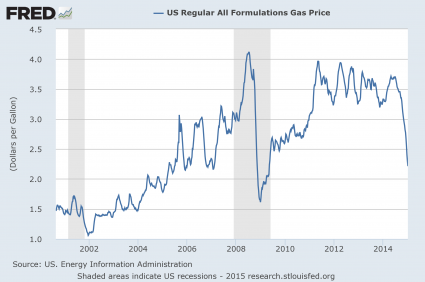
#7 A broad range of industrial commodities begin to decline in price. When industrial commodities go down in price, that is a sign that economic activity is slowing down. And just like in 2008, that is what we are watching unfold on the global stage right now. The following is an excerpt from a recent CNBC article…
From nickel to soybean oil, plywood to sugar, global commodity prices have been on a steady decline as the world’s economy has lost momentum.
For an extended discussion on this, please see my recent article entitled “Not Just Oil: Guess What Happened The Last Time Commodity Prices Crashed Like This?”
#8 A junk bond crash. Just like in 2008, we are witnessing the beginnings of a junk bond collapse. High yield debt related to the energy industry is on the bleeding edge of this crash, but in recent weeks we have seen investors start to bail out of a broad range of junk bonds. Check out this chart and this chart in addition to the chart that I have posted below…
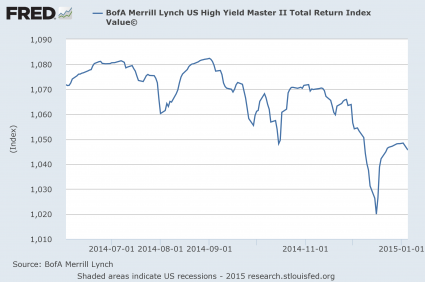
#9 Global inflation slows down significantly. When economic activity slows down, so does inflation. This is something that we witnessed in 2008, this is also something that is happening once again. In fact, it is being projected that global inflation is about to fall to the lowest level that we have seen since World War II…
Increases in the prices of goods and services in the world’s largest economies are slowing dramatically. Analysts are predicting that inflation will fall below 2pc in all of the countries that make up the G7 group of advanced nations this year – the first time that has happened since before the Second World War.
Indeed, Japan was the only G7 country whose inflation rate was above 2pc last year. And economists believe that was because its government increased sales tax which had the effect of artificially boosting prices.
#10 A crisis in investor confidence. Just prior to the last financial crisis, the confidence that investors had that we would be able to avoid a stock market collapse in the next six months began to decline significantly. And guess what? That is something else that is happening once again…
Investor confidence that the US will avoid a stock-market crash in the next six months has dropped dramatically since last spring.
The Yale School of Management publishes a monthly Crash Confidence Index. The index shows the proportion of investors who believe we will avoid a stock-market crash in the next six months.
Yale points out that “crash confidence reached its all-time low, both for individual and institutional investors, in early 2009, just months after the Lehman crisis, reflecting the turmoil in the credit markets and the strong depression fears generated by that event, and is plausibly related to the very low stock market valuations then.”
Are you starting to get the picture?
And of course I am not the only one warning about these things. As I wrote about earlier in the week, there are a whole host of prominent voices that are now warning of imminent financial danger.
Today, I would like to add one more name to the list. He is respected author James Howard Kunstler, and what he predicts is coming in 2015 is absolutely chilling…
*****
Here are my financial forecast particulars for 2015:
- Early in 2015 the ECB proposes a lame QE program and is laughed out of the room. European markets tank.
- Greek elections in January produce a government that stands up to the EU and ECB and causes a fatal slippage of faith in the ability of that project to continue.
- Second half of 2015, the rest of the world gangs up and counter-attacks the US dollar.
- Bond markets in Europe implode in first half and the contagion spreads to the US as fear and distrust rises about viability of US safe haven status.
- Derivatives associated with currencies, interest rates, and junk bonds trigger a bloodbath in credit default swaps (CDS) and the appearance of countless black holes through which debt and “wealth” disappear forever.
- US stock markets continue to bid upward in the first half of 2015, crater in Q3 as faith in paper and pixels erodes. DJA and S & P fall 30 to 40 percent in the initial crash, then further into 2016.
- Gold and silver slide in the first half, then take off as debt and equity markets craters, faith in abstract instruments evaporates, faith in central bank omnipotence dissolves, and citizens all over the world desperately seek safety from currency war.
- Goldman Sachs, Citicorp, Morgan Stanley, Bank of America, DeutscheBank, SocGen, all succumb to insolvency. American government and Federal Reserve officials don’t dare attempt to rescue them again.
- By the end of 2015, central banks everywhere stand in general discredit. In the US, the Federal Reserve’s mandate is publically debated and revised back to its original mission as lender of last resort. It is forbidden to engage in further interventions and a new less-secretive mechanism is drawn up for regulating basic interest rates.
- Oil prices creep back into the $65 – $70 range by May 2015. It is not enough to halt the destruction in the shale, tar sand, and deepwater sectors. As contraction in the failing global economy accelerates, oil sinks back to the $40 range in October…
- …unless mischief in the Middle East (in particular, the Islamic State messing with Saudi Arabia) leads to gross and perhaps fatally permanent disruption in world oil markets — and then all bets are off for both the continuity of advanced economies and for peace between nations.
*****
Personally, I don’t agree with Kunstler on all of the particulars and the timing of certain events, but overall I think that we are going to look back when the year is done and say that he was a lot more right than he was wrong.
We are moving into a time of extreme danger for the global economy. There has never been a time when I have been more concerned about a new year since I began The Economic Collapse Blog back in 2009.
Over the past couple of years, we have been very blessed to be able to enjoy a bubble of relative stability. But this period of stability also fooled many people into thinking that our economic problems had been fixed, when in reality they have only gotten worse.
We consume far more wealth than we produce, our debt levels are at record highs and we are at the tail end of the largest Wall Street financial bubble in all of history.
It is inevitable that we are heading for a tragic conclusion to all of this. It is just a matter of time.
 Are you ready for what is coming in August? All over America, economic, political and social tensions are building, and the next 30 days could turn out to be pivotal. In July, we saw things start to turn. As you will read about below, a major six year trendline for the S&P 500 was finally broken this month, Chinese stocks crashed, commodities crashed, and debt problems started erupting all over the planet. I fully expect that this next month (August) will be a month of transition as we enter an extremely chaotic time in the fall and winter. Things are unfolding in textbook fashion for another major global financial crisis in the months ahead, and yet most people refuse to see what is happening. In their blind optimism, they want to believe that things will somehow be different this time. Well, the coming months will definitely reveal who was right and who was wrong. The following are 11 red flag events that just happened as we enter the pivotal month of August 2015…
Are you ready for what is coming in August? All over America, economic, political and social tensions are building, and the next 30 days could turn out to be pivotal. In July, we saw things start to turn. As you will read about below, a major six year trendline for the S&P 500 was finally broken this month, Chinese stocks crashed, commodities crashed, and debt problems started erupting all over the planet. I fully expect that this next month (August) will be a month of transition as we enter an extremely chaotic time in the fall and winter. Things are unfolding in textbook fashion for another major global financial crisis in the months ahead, and yet most people refuse to see what is happening. In their blind optimism, they want to believe that things will somehow be different this time. Well, the coming months will definitely reveal who was right and who was wrong. The following are 11 red flag events that just happened as we enter the pivotal month of August 2015…


